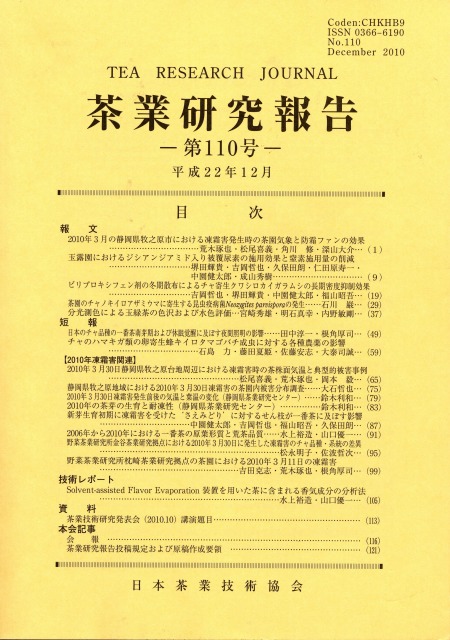Volume 2010, Issue 110
TEA RESEARCH JOURNAL No.110
Displaying 1-17 of 17 articles from this issue
- |<
- <
- 1
- >
- >|
Original Articles
-
2010Volume 2010Issue 110 Pages 110_1-110_8
Published: December 31, 2010
Released on J-STAGE: January 09, 2013
Download PDF (971K) -
2010Volume 2010Issue 110 Pages 110_9-110_18
Published: December 31, 2010
Released on J-STAGE: January 09, 2013
Download PDF (1086K) -
2010Volume 2010Issue 110 Pages 110_19-110_28
Published: December 31, 2010
Released on J-STAGE: January 09, 2013
Download PDF (1244K) -
2010Volume 2010Issue 110 Pages 110_29-110_36
Published: December 31, 2010
Released on J-STAGE: January 09, 2013
Download PDF (849K) -
2010Volume 2010Issue 110 Pages 110_37-110_47
Published: December 31, 2010
Released on J-STAGE: January 09, 2013
Download PDF (945K)
Short Communication
-
2010Volume 2010Issue 110 Pages 110_49-110_57
Published: December 31, 2010
Released on J-STAGE: January 09, 2013
Download PDF (900K) -
2010Volume 2010Issue 110 Pages 110_59-110_64
Published: December 31, 2010
Released on J-STAGE: January 09, 2013
Download PDF (755K)
Short reports of Frost damage in 2010
-
2010Volume 2010Issue 110 Pages 110_65-110_73
Published: December 31, 2010
Released on J-STAGE: January 09, 2013
Download PDF (1181K) -
2010Volume 2010Issue 110 Pages 110_75-110_78
Published: December 31, 2010
Released on J-STAGE: January 09, 2013
Download PDF (856K) -
2010Volume 2010Issue 110 Pages 110_79-110_81
Published: December 31, 2010
Released on J-STAGE: January 09, 2013
Download PDF (1059K) -
2010Volume 2010Issue 110 Pages 110_83-110_85
Published: December 31, 2010
Released on J-STAGE: January 09, 2013
Download PDF (859K) -
2010Volume 2010Issue 110 Pages 110_87-110_90
Published: December 31, 2010
Released on J-STAGE: January 09, 2013
Download PDF (774K) -
2010Volume 2010Issue 110 Pages 110_91-110_94
Published: December 31, 2010
Released on J-STAGE: January 09, 2013
Download PDF (748K) -
2010Volume 2010Issue 110 Pages 110_95-110_98
Published: December 31, 2010
Released on J-STAGE: January 09, 2013
Download PDF (815K) -
2010Volume 2010Issue 110 Pages 110_99-110_103
Published: December 31, 2010
Released on J-STAGE: January 09, 2013
Download PDF (825K)
Technical Reports
-
2010Volume 2010Issue 110 Pages 110_105-110_112
Published: December 31, 2010
Released on J-STAGE: January 09, 2013
Download PDF (876K)
Note
-
2010Volume 2010Issue 110 Pages 110_113-110_115
Published: December 31, 2010
Released on J-STAGE: January 09, 2013
Download PDF (586K)
- |<
- <
- 1
- >
- >|
